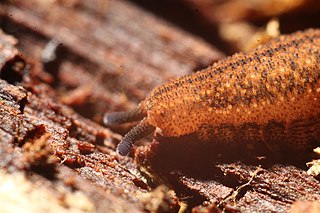Related Research Articles

Leucopatus is a genus of velvet worm in the family Peripatopsidae, containing a single species, the blind velvet worm. It is found in northeast Tasmania, Australia, and is ovoviviparous.

Peripatopsidae is one of the two living velvet worm families.
Leuropezos is a monospecific genus of velvet worm containing the single species Leuropezos eungellensis. The type locality of this species is Eungella National Park, Queensland, Australia.

Occiperipatoides is a monospecific genus of velvet worm containing the single species Occiperipatoides gilesii. This genus is ovoviviparous and found in Western Australia. The genus is part of the ancient phylum Onychophora that contains soft-bodied, many-legged relatives of arthropods known commonly as velvet worms.

Kumbadjena is a genus of velvet worms in the family Peripatopsidae. All species in this genus are ovoviviparous, all have 15 pairs of oncopods (legs), and all are found in the southwest of Western Australia.
Ooperipatus is a genus of Australian velvet worms in the Peripatopsidae family. All species in this genus are oviparous and have 15 pairs of oncopods (legs).

Ooperipatellus is a genus of Australian and New Zealand velvet worms in the Peripatopsidae family. Species in this genus are oviparous. Velvet worms in this genus are among the smallest known, with adults often only 10 to 20 millimeters long. Morphological and molecular data indicate that this genus is a monophyletic group.
Florelliceps is a monospecific genus of ovoviviparous velvet worm containing the single species Florelliceps stutchburyae. This species is brown with 15 pairs of oncopods (legs). During mating, the male of this species uses a structure on his head to place a spermataphore on the gonopore of the female. The type locality is Mount Warning, New South Wales, Australia.
Euperipatoides leuckarti is a species of velvet worm in the family Peripatopsidae. This species is ovoviviparous and has 15 pairs of oncopods (legs). The type locality of this species is Mount Tomah, New South Wales, Australia.

Tasmanipatus barretti, the giant velvet worm, is a species of velvet worm in the Peripatopsidae family. It is the sole species in the genus Tasmanipatus and is ovoviviparous.
Cephalofovea cameroni is a species of ovoviviparous velvet worm in the family Peripatopsidae. This species has 15 pairs of oncopods (legs) and lives in rotting logs and leaf litter. The type locality is Rydal, New South Wales, Australia. Like all members of the genus Cephalofovea, both sexes of C. cameroni have a furrow on the head, between the antennae, which the male everts to carry his spermatophore to the female.
Cephalofovea clandestina is a species of ovoviviparous velvet worm in the family Peripatopsidae. This species has 15 pairs of oncopods (legs) and lives in rotting logs and leaf litter. The type locality is Kanangra-Boyd National Park, New South Wales, Australia. Like all members of the genus Cephalofovea, both sexes of C. clandestina have a furrow on the head, between the antennae, which the male everts to carry his spermatophore to the female.

Kumbadjena kaata is a species of velvet worm in the family Peripatopsidae. This species has 15 pairs of legs. The type locality is in Western Australia.
Kumbadjena occidentalis is a species of velvet worm in the family Peripatopsidae described by Joseph James Fletcher in 1895. This species has 15 pairs of legs. The type locality is in Western Australia.
Kumbadjena shannonensis is a species of velvet worm in the Peripatopsidae family. This species has 15 pairs of legs. The type locality is in Western Australia.
Ruhbergia bifalcata is a species of velvet worm in the family Peripatopsidae. The type locality is in New South Wales, Australia.
Ruhbergia brevicorna is a species of velvet worm in the Peripatopsidae family. The type locality is in New South Wales, Australia.
Ruhbergia rostroides is a species of velvet worm in the Peripatopsidae family. The type locality is in New South Wales, Australia.
Ooperipatellus insignis is a species of velvet worm in the family Peripatopsidae. This species has 14 pairs of legs and is found in Victoria, Australia.
Planipapillus cyclus is a species of velvet worm in the Peripatopsidae family. This species is oviparous, has 15 pairs of legs, and lives in logs in wet forests. It is found in Victoria, Australia.
References
- ↑ Oliveira, I.; Hering, L. & Mayer, G. "Updated Onychophora checklist". Onychophora Website. Retrieved 24 November 2016.
- ↑ Monge-Nájera, Julián (1994). "Reproductive trends, habitat type and body characteristcs in velvet worms (Onychophora)". Revista de Biología Tropical: 611–622. ISSN 2215-2075.
- ↑ "Australian Faunal Directory". Australian Government Department of the Environment. Retrieved 29 June 2016.